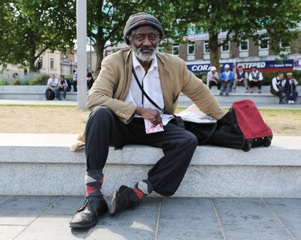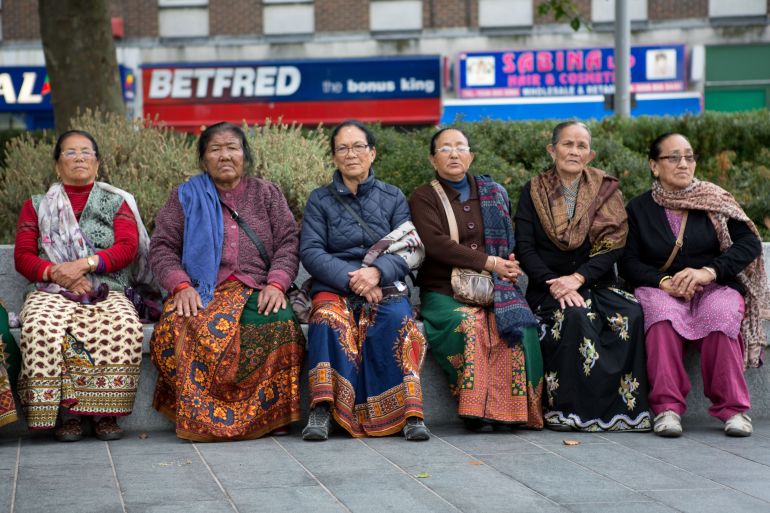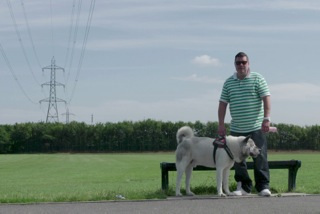Benches for everyone: solitude in public, sociability for free.
“You can smoke out here, you can shout, and do what you like as no-one is telling you what to do… this is your own little bench… no-one should be able to tell you what to do if you’re sitting on a bench.”
Most days Colin sits on one of the benches in a large grassy open space in suburban south London; he walks his dog, drinks some cans and chats with his friend Phil. Phil talks about the bench as social space, “People will kind of beeline for us. They could be any people in the world, we make them laugh and cheer them up a bit in the day when we’ve sat on the bench. Sit down and have a laugh”.
Everyone instinctively understands the fundamentals of benches, they are public provision, egalitarian in their welcome, free to use. But research focused on urban benches runs the risk of sounding whimsical and peripheral to the main concerns of life. People living in our London case study neighbourhoods deal with social and political contexts shaped by austerity policies, the housing crisis, precarity of employment and a breakdown in support services. What do they care about benches?

Our collaborative research project worked with community fieldworkers and a filmmaker to explore aspects of sitting outside in an urban square (General Gordon Square, Woolwich, designed by Gustafson Porter) and a large grassed open space (St Helier Open Space, Sutton, council owned and managed). What where are the pleasures, where are the conflicts, and what is the relationship between these and public realm design and management?
Our findings threw a sharp light on the ways in which many people spend time public space to actively improve their own quality of life. Using benches was crucial for mental health and social inclusion for many people in our case study sites. A busy mother who regularly sat on the benches in St Helier Open Space saw this time as “bringing my senses alive, it’s the only time they come alive really” and even the busy square in Woolwich was often described as ‘peaceful’. Bench-space gives a chance to mull, to ‘sort out your day” and gives a sense of ‘feeling free’- a particular form of restoration which combines mental processing with the welcome distraction of people watching. Solitude is often overlayed with sociability, with loose meetings as well as arranged get-togethers.
Places to sit outside are welcomed by many, but are often essential for those largely marginalised from work, education or more convivial leisure locations. Not everyone can afford a posh coffee every time they leave the house, so the free provision of benches is welcomed in increasingly commercialised urban environments. Most of our interviewees found time spent on benches to be a welcome break from homes that felt crowded, lonely or simply boring. Sitting outside allows for a sense of belonging in the flow of city life, an undemanding participation.
If landscape architecture is to have any ambitions to work towards environmental equity and social inclusion, we need to acknowledge that though public space is ‘for all’, it is more crucial for these long-stay users, who often spending hours hanging out on benches. Our film shows an intriguing insight into the mix of these: teenagers and young adults who like meeting up in large fluid friendship groups, carers of children and adults with disabilities, groups of elderly Nepali migrants in Woolwich, middle aged and elderly men who are ‘down on their luck’, unemployed and often alcohol dependent, parents of young children. Their sitting-space overlaps with quicker turnovers of short-stay users; ambulance workers having a snatched quiet moment and a smoke, a girl catching up on texts before getting on a bus, an elderly person needing a sit down en route to the local shops.

Particular ‘types’ of users are often cast as problematic or anti-social. Their ways of spending time in public space can be actively designed against, from dispersal orders to removal of seating or specification of uncomfortable seating. This diminishes the quality of public space for everyone. We found that people using benches minimise possible conflict and find places to sit where they feel comfortable, high levels of visibility allow these micro-decisions to be made easily. There is a positive choice to spend time alongside others, the diversity is important, a reflection of where you are and who you live among. This needs to be supported by seating design that allows for comfort, conversations and people-watching, and management of public spaces that improves safety through accommodating a mix of uses and users.
Our research articulates the importance of benches in public space in our ‘Manifesto of the Good Bench’, evidenced and presented in our report ‘Benches for everyone: solitude in public, sociability for free’ published by The Young Foundation. We highlight six points for action.
- Benches should be recognised and promoted as a social good, core to supporting mental health and active lifestyles policies. Local strategies should address inequality in quantity and quality of benches in urban locations, and these should reflect the access and wellbeing requirements of different users of benches.
- Formal and incidental public spaces should be maximised as local social resources by clustering of benches and their co-location with leisure facilities and other services.
- Design of public spaces should increase the quantity and diversity of non-commercial seating.
- Benches need to be comfortable as well as robust.
- Management of public spaces should ensure hanging out is legitimised as a non-criminal activity: balancing safety agendas with a meaningful inclusivity of diverse people and activities.
- Minimise potential conflict to reduce reliance on explicit security measures. Key aims should be to support high pedestrian movement through open space networks, maintain good visibility, zone quieter and noisier areas, and give options of where to sit.
The research was funded through the Arts and Humanities Research Council Connected Communities programme. It was a collaboration between the University of Sheffield, The Young Foundatiuon, Greenwich Inclusion Project, Sheffield Hallam University and the University of Sussex.
The Bench project website: resources and film clip.
@benchprojectLDN




I agree about the benefits of benches. I am always looking for one at stations, as I tire quite quickly, and there aren’t enough. Where there are it’s very enjoyable - Euston has an area outside with food and drink stalls either side, which has a nice atmosphere.
Jane
LikeLike